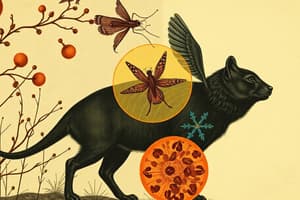Podcast
Questions and Answers
Fertilization occurs after the fusion of ______ and sperm cells
Fertilization occurs after the fusion of ______ and sperm cells
egg
Sperm cells are produced in the ______ in males
Sperm cells are produced in the ______ in males
testes
Egg cells are produced in the ______ in females
Egg cells are produced in the ______ in females
ovaries
Ejaculation deposits sperm cells in the ______ or cervix
Ejaculation deposits sperm cells in the ______ or cervix
When a sperm cell reaches the egg cell, it creates a hole through the egg cell's outer layer called ______
When a sperm cell reaches the egg cell, it creates a hole through the egg cell's outer layer called ______
The sperm cell enters the ______ cell, and its nucleus fuses with the egg cell's nucleus, creating a diploid zygote.
The sperm cell enters the ______ cell, and its nucleus fuses with the egg cell's nucleus, creating a diploid zygote.
After fertilization, the zygote undergoes a series of rapid cell divisions, forming a hollow ball of cells called a ______.
After fertilization, the zygote undergoes a series of rapid cell divisions, forming a hollow ball of cells called a ______.
Advanced reproductive technologies, like in vitro fertilization (IVF), have revolutionized the ability to help individuals and couples overcome fertility challenges. IVF involves the collection of eggs and ______, their fertilization in a lab.
Advanced reproductive technologies, like in vitro fertilization (IVF), have revolutionized the ability to help individuals and couples overcome fertility challenges. IVF involves the collection of eggs and ______, their fertilization in a lab.
Fertilization is a dynamic and intricate process that ensures the continuation of species by combining the genetic material of two individuals. This event kicks off a series of changes and developments that ultimately lead to the creation of a new, unique ______ form.
Fertilization is a dynamic and intricate process that ensures the continuation of species by combining the genetic material of two individuals. This event kicks off a series of changes and developments that ultimately lead to the creation of a new, unique ______ form.
Understanding fertilization can provide valuable insights into the complexities of reproduction and the numerous challenges that couples and individuals may face when trying to ______.
Understanding fertilization can provide valuable insights into the complexities of reproduction and the numerous challenges that couples and individuals may face when trying to ______.
Study Notes
Reproduction: An Overview of Fertilization
Reproduction is a fundamental process that ensures the continuation of species across generations. Fertilization, which occurs after the fusion of egg and sperm cells, is a crucial step in sexual reproduction. This article delves into the fascinating and intricate details of fertilization, shedding light on this vital stage in the reproductive cycle.
Sperm and Egg Preparation
Before fertilization can occur, sperm and egg cells need to be prepared for the encounter. Sperm cells, also known as spermatozoa, are produced in the testes in males and mature in the seminiferous tubules. Egg cells, or oocytes, are produced in the ovaries in females and undergo a series of changes during a process called meiosis, resulting in a single egg cell and several smaller cells called polar bodies.
The Gamete Meeting
Fertilization typically takes place in the female reproductive tract. Ejaculation deposits sperm cells in the vagina or cervix, where they swim towards the uterus and fallopian tubes. Egg cells are released into the fallopian tubes during the menstrual cycle, during a process called ovulation. The sperm cells must navigate the female reproductive tract to encounter the egg cell, a journey that can take up to five days.
The Fusion of Gametes
When a sperm cell reaches the egg cell, it attaches to it and releases enzymes that create a hole, or corona radiata, through the egg cell's outer layer. The sperm cell then enters the egg cell, and its nucleus fuses with the egg cell's nucleus, creating a diploid zygote. This fusion of gametes results in the genetic combination of the two parents' DNA, ensuring genetic variation in the offspring.
The Early Development Stages
After fertilization, the zygote undergoes a series of rapid cell divisions, forming a hollow ball of cells called a blastocyst. The blastocyst then implants itself into the uterine wall, where it continues to grow and develop.
The Role of Assisted Reproductive Technologies
Advanced reproductive technologies, like in vitro fertilization (IVF), have revolutionized the ability to help individuals and couples overcome fertility challenges. IVF involves the collection of eggs and sperm, their fertilization in a lab, and the subsequent development of an embryo, which is then implanted into the uterus.
Conclusion
Fertilization is a dynamic and intricate process that ensures the continuation of species by combining the genetic material of two individuals. This event kicks off a series of changes and developments that ultimately lead to the creation of a new, unique life form. Understanding fertilization can provide valuable insights into the complexities of reproduction and the numerous challenges that couples and individuals may face when trying to conceive.
Studying That Suits You
Use AI to generate personalized quizzes and flashcards to suit your learning preferences.
Description
Test your knowledge on the crucial process of fertilization in reproduction with this quiz. Explore the details of sperm and egg preparation, the journey of gametes meeting, the fusion process, early development stages, and the role of assisted reproductive technologies like IVF. Challenge yourself on this fascinating topic!




